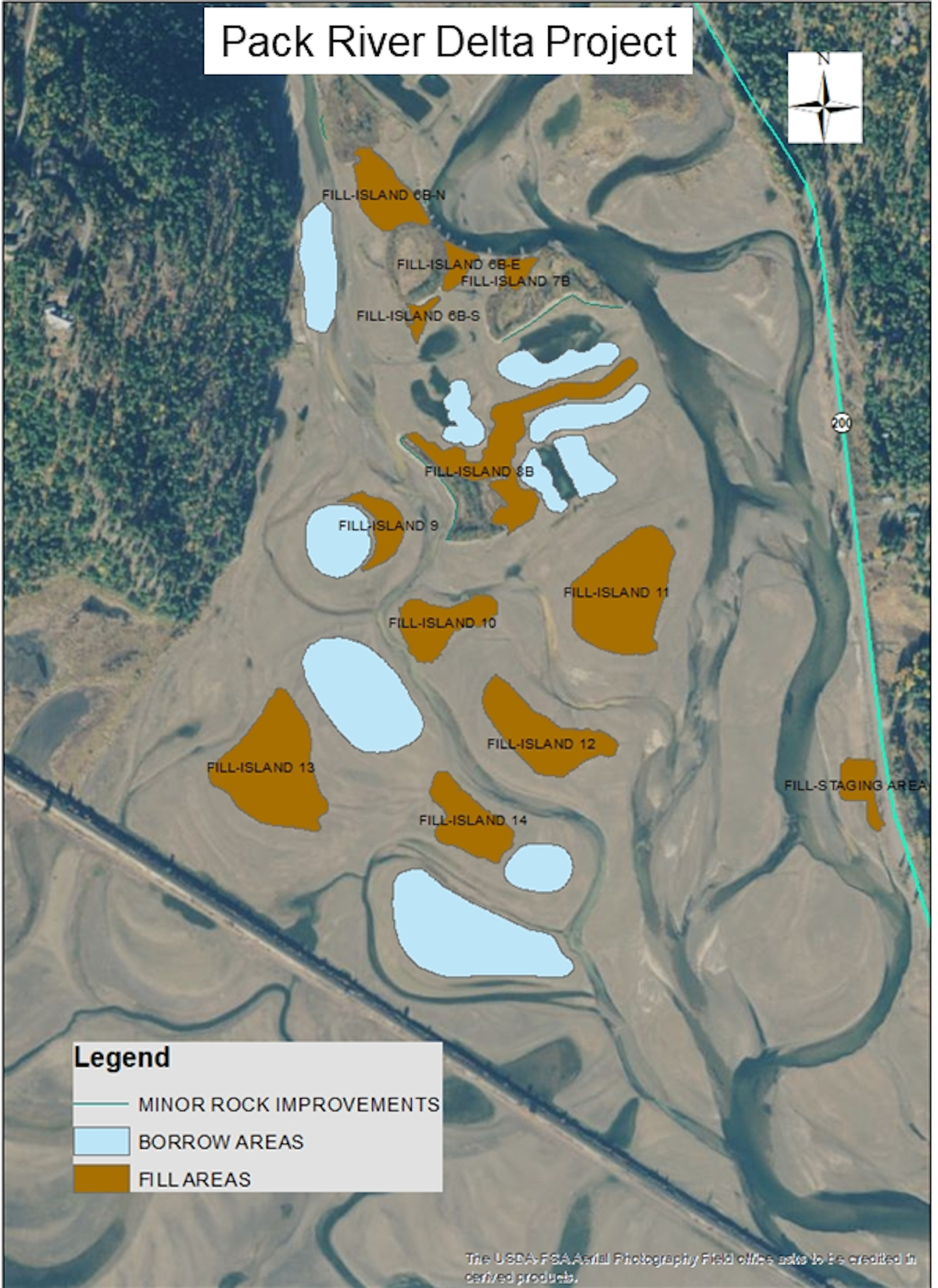Restoration finishing up in Pack River Delta
▶️ Audio story available.
A second restoration project is underway at the Pack River Delta, and Idaho Department of Fish and Game officials said things may look crazy on site for a little longer while construction finishes up.
The restoration project is focusing on recreating wetlands in the delta that have been destroyed from the building of dams, mostly Albeni Falls Dam.
“Historically, the wetlands on these deltas were mainly seasonal wetlands,” Pete Rust, IDFG mitigation staff biologist and project manager, said. “They would flood during spring runoff, then the water would recede in the summer. After the dams went in during the 1950s … the wetlands were submerged all summer and they died. Once the vegetation was gone, erosion became an issue with nothing to bind the soils and protect them from the power of the lake’s wind and waves. We’ve lost — by some estimates over 6,000 acres — several thousand acres of wetland vegetation in the Clark Fork and Pack River deltas.”
IDFG staff are working to protect the remaining islands and shorelines from future erosion by armoring them with rock and planting different types of vegetation to help the soil remain sturdy. Additionally, Fish and Game will work to create new islands and new habitat for the lake’s wildlife. The Pack River Delta does not have many remaining islands left after most disappeared with the high water levels, Rust said, so most of the project has been focused on the creation of the new islands.
The department’s goal is to create nine new islands by the end of the project as well as multiple new emergent zones — middle areas for bulrushes and cattails that sit at the water's edge. Additionally, the project will create 10 new deeper water habitats, which are the source of the base of the man-made islands, Rust said.
“We will be seeding all the new islands we’re creating and planting over 60,000 native plants,” he said. “We expect to be done with construction by early April. We will be doing most of the planting in late June.”
Until April, Rust said the area looks a lot more chaotic than it actually is, and doesn’t want the public to put stock in any rumors they may have heard about construction in the area.
“We are not building any human housing on the delta,” he said. “This project is intended to reduce erosion, create wildlife habitat and improve access for people to enjoy what we’ve created. It takes a lot of equipment to do these types of projects in that environment, and we need to get finished before the lake comes up in the spring. It will look a lot different and better after construction.”
The project manager said the roads and bridge built in the delta will be removed after construction, and an equipment staging area will be scaled down to a small parking lot with a primitive boat ramp and kayak loading area. The surrounding area will be planted with native shrubs and plants.
“We want to create and improve habitat for wildlife in general, but our main priority is to improve … nesting habitat for waterfowl and other game species,” Rust said.
While Rust said the deltas and wetlands hold a multitude of cultural significance, they are also vital for many nesting birds and spawning fish.
“Wetlands are important because they can help control flooding, improve water quality, reduce erosion, slow down the flow of water so they increase ground water recharge, and they store excess nutrients,” he said. “All the deltas are important, but the Clark Fork and Pack River deltas are the two largest on the lake, and once provided large expanses of habitat for waterfowl nesting and migration.”
Rust said that IDFG is not against the dams that have been built on the lake, as staff appreciates the cheap electricity it provides as well as enjoy recreating on the full lake in the summers.
“We are just trying to save what’s left of the delta habitats and create new habitats that function better under our current water level management regime,” he said.
There are currently no restrictions in place for the Pack River Delta, aside from a request that people avoid the staging area where the heavy equipment is currently parked. Rust said he understands this will cause an inconvenience to some, but appreciates the cooperation for the short-term project.
“Hunters need to be aware of the equipment operators working on the project and be careful of where they shoot,” he said.
This second restoration project is part of a 10-year agreement between IDFG and Bonneville Power Administration to mitigate the loss of habitat around Lake Pend Oreille. This will be the third project completed during the agreement that started in 2018. This project is the second phase in a much larger restoration plan, Rust said, and it is unclear when the next phase will begin.
“I’m in the process of determining how much money, if any, I have left for a third phase,” he said. “We will likely have enough for a final smaller project under this funding agreement.”
Right now, IDFG is looking at working on the south side of the railroad tracks to potentially create a few small islands and a smaller breakwater near the west side of that same area off of Sunnyside Road for the third phase.
“It would be nice to add some new habitat and diversity to that area,” Rust said. “That would really create some great fish and wildlife habitat and would be great for the waterfowl hunters to have islands out there. We will see. At this point, that will be the last restoration project until we find additional funding.”
Visit the Idaho Fish and Game Panhandle Region Facebook page for updates on the Pack River Delta project.



